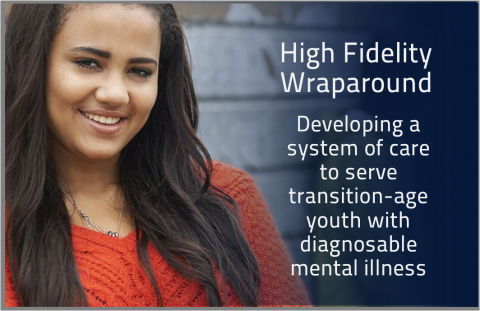Ohio Department of Mental Health and Addiction Services (ODMHAS) is developing a state-wide system of care framework that coordinates and adapts policy, fiscal and administrative actions to support the successful transition of Ohio’s youth and young adults. CIP was selected to be the training and consultation resource for the implementation and dissemination of high quality wraparound care across the state.
Wraparound is s part of the ENGAGE Initiative (Engaging the New Generation to Achieve their Goals through Empowerment). The Ohio Department of Mental Health and Addiction Services (OhioMHAS) has received a four-year grant from the Substance Abuse and Mental Health Services Agency (SAMHSA) to expand the system of care approach throughout Ohio for youth and young adults, ages 14 through 21 with mental health challenges, co-occurring disorders, and multi-system needs.
The Center for Innovative Practices received an award from the Ohio Department of Mental Health and Addiction Services (OMHAS) to be the training and consultation resource for the implementation and dissemination of high quality Wrap Around across the state. CIP staff and consultants will work with OMHAS to develop and implement both the training for Wrap Around and the coaching and support that counties will need to achieve quality outcomes from the Wrap Around process.
Ohio Family and Children First is serving as a partner with OhioMHAS to implement this four-year grant called ENGAGE (Engaging the New Generation to Achieve their Goals through Empowerment). The goal is to develop a statewide system of care framework that coordinates and adapts policy, fiscal and administrative actions to support the successful transition of Ohio’s youth and young adults. Ohio has developed a four-year plan to expand the system of care framework statewide focused on youth and young adults.
Transition-age youth are adolescents and young adults (ages 14-25) who have a diagnosable mental illness that has led to impaired functioning in one or more life domains. Examples of life domains include housing, education and employment, quality of life and functioning and life skills.
Developmentally, transition-age youth are interdependent, seeking their own identity and independence while still partially dependent on the support of family members, caregivers and service providers. Best practices for serving transition-age youth incorporate the principles of recovery, resiliency and cultural competence. In addition, the overall care must be youth-guided and family-driven.
How and why wraparound works
Wraparound has always had implicit associations with various psychosocial theories, however, until recently only preliminary efforts had been undertaken to explain in a thorough manner why the wraparound process should produce desired outcomes. The Wraparound theory assumes that, when wraparound is undertaken in accordance with the principles and the practice model specified by the NWI, the result is an effective team process that capitalizes on the expertise and commitment of all team members while also prioritizing the perspectives of the youth and family. When the wraparound process is carried out with fidelity to the principles and the practice model, it is an engagement and planning process that promotes a blending of perspectives and high-quality problem solving.
Studies of wraparound
Does Team-Based Planning ‘Work’ for Adolescents?
This article focuses on wraparound as an example of a team planning process, and uses data from several sources to reflect on questions about whether-and under what conditions-collaborative teams are successful in engaging young people-and their caregivers-in planning. We used data collected in three studies to address our research questions. The first data set comes from a study on wraparound service planning in Nevada. We examined data collected from 23 matched pairs of caregivers and youth at 6 months after wraparound planning began. Our second data set came from a national study of 41 local wraparound programs throughout the United States.
Phases and activities of the wraparound process
“Phases and Activities of the Wraparound Process” focuses on what needs to happen in wraparound; however, how the work is accomplished is equally important. Merely accomplishing the tasks is insufficient unless this work is done in a manner consistent with the 10 principles of wraparound. In addition, future work from the National Wraparound Initiative will provide more detailed information about team member skills that are necessary for the wraparound process, as well as descriptions of specific procedures, templates, and other tools that can be used to complete the activities described.
Ten principles of wraparound
The philosophical principles of wraparound have long provided the basis for understanding this innovative and widely-practiced service delivery model. This value base for working in collaboration and partnership with families extends from wraparound’s roots in programs such as Kaleidoscope in Chicago, the Alaska Youth Initiative, and Project Wraparound in Vermont. In 1999, a monograph on wraparound was published that presented 10 core elements of wraparound, as well as 10 practice principles, from the perspective of wraparound innovators. For many, these original elements and principles became the best means available for understanding the wraparound process. They also provided an important basis for initial efforts at measuring wraparound fidelity.
Wraparound and natural supports
The Wraparound theory assumes that, when wraparound is undertaken in accordance with the principles and the practice model specified by the NWI, the result is an effective team process that capitalizes on the expertise and commitment of all team members while also prioritizing the perspectives of the youth and family…When the wraparound process is carried out with fidelity to the principles and the practice model, it is an engagement and planning process that promotes a blending of perspectives and high-quality problem solving, and is thus consistent with empirically supported best practices for effective teamwork…As a wraparound trainer and coach, I support facilitators as they learn the craft of wraparound.
Additional resources
- Ohio Department of Mental Health and Addiction Services (OhioMHAS)
- National Network on Youth Transition (NNYT) for Behavioral Health
- ENGAGE 1st Cohort Webinar – May 2014


